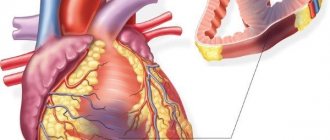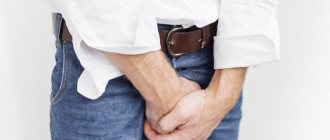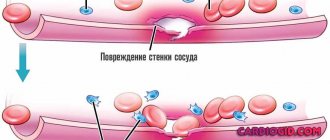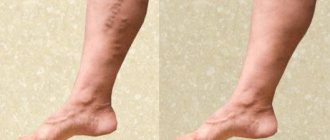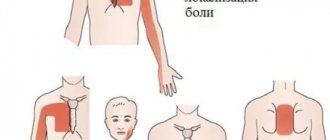The danger of protruding veins on the legs
When the veins do not protrude much on the legs, they speak of the initial stage of the disease. During this period, the patient is more concerned about a cosmetic defect than physical suffering. But in the absence of proper treatment, the disease progresses. Then, in addition to the cosmetic defect, pain and a feeling of heaviness in the legs are added. They are caused by an increased load on the vessels of the lower extremities. Typically, bulging veins appear due to varicose veins. Another reason is a cholesterol clot that has blocked the vessel.
With prolonged development, the disease poses a threat to human life. The patient develops congestion when the blood circulates poorly and is not saturated with oxygen. Because of this, there is a deficiency of nutrients in tissues and organs. The consequence of this is atrophic changes in the skin.
Protruded vessels are easy to damage. They can burst even from a normal blow. In this case, there is a high probability that the bleeding will not stop on its own. Then there is a need for sutures, even if the rupture occurs under the skin.
Diagnosis and treatment
Varicose veins in the legs and feet are not just a cosmetic defect. This is a disease that should be treated seriously and carefully. If you notice symptoms, you should consult a doctor. He will prescribe a Doppler ultrasound. It will show the quality of blood circulation and detect the presence of obstructions, if any.
At the initial stages, it is recommended to treat varicose veins using ointments and gels. They help relieve swelling, relieve pain and fatigue. Of course, the impact of beneficial substances is minimal, but for the initial stage this is quite enough.
There are special venotonics that are prescribed by the doctor. They also relieve swelling, reduce pain and tighten the walls of blood vessels. They can be used in combination with ointments.
Vein dilatation is treated with endovasal laser coagulation. The procedure involves exposing the diseased vessel to a laser. It is performed under local anesthesia. After the procedure, the stars disappear.
Now a new method of treating the disease has emerged. This is ozone therapy, which involves introducing ozone into the lumens of blood vessels using a microneedle. As a result, the gaps stick together. Several such procedures allow you to quickly experience visible results.
Some resort to a radical method - removing the vein through surgery. To do this, a small puncture is made in the leg. After some time it becomes invisible. The next day after the operation, the patient is sent home. But for a month he needs to wear special tights or bandage his leg.
Causes of varicose veins
Veins in the legs protrude due to a hereditary predisposition if the initial symptoms appeared in a person before he reached 40 years of age. In women, pathological changes in the condition of blood vessels often occur during pregnancy due to displacement of internal organs. In the last weeks of pregnancy, the fetus puts especially strong pressure on deep veins. Because of this, stagnation develops in a separate section of the vein, and hemodynamic pressure increases.
Often the reasons why veins bulge are the following:
- excess body weight;
- physical labor in difficult conditions;
- leg injuries;
- addiction to alcoholic beverages and nicotine;
- hormonal imbalances;
- great physical activity.
The disease develops faster with improperly selected shoes or clothing. Women often wear uncomfortable shoes and tight clothes in an attempt to look slimmer. In reality, tight shoes and tight clothing provoke diseases of the cardiovascular system and an increase in blood pressure in deep vessels. First, negative changes affect the superficial veins. If left untreated, the disease spreads to deep vessels.
In men, in addition to the main reasons, heavy lifting, for example, squats with heavy weights, leads to the development of varicose veins. The situation is aggravated by simultaneous use of steroid drugs. Sometimes vein diseases develop in teenagers. Then the cause becomes hormonal changes in the body.
What to do during pregnancy
During pregnancy, veins in the legs pop out very often. Therefore, from the first weeks of excellent condition, you need to:
- wear comfortable underwear, clothes and shoes;
- do not lift heavy objects;
- wear compression garments and a bandage at a later stage, and also, with the permission of a doctor, use folk remedies and medical drugs such as Troxevasin, Detralex and others.
Pregnant women should always sit and lie comfortably, try to take positions so that the blood vessels are not pinched and the blood flow is not disturbed.
Now you know when the veins on the legs protrude, the reasons for the appearance of varicose veins, methods of combating this disease and ways to prevent it. Carefully examine your feet when taking a shower, do not “turn a blind eye” to swelling, aching pain and cramps, seek medical help and you can avoid serious health problems.
Symptoms of the disease
At the initial stage, pathology is very difficult to identify. There are no changes on the outside of the legs; there is also no pain or swelling. Over time, the functioning of the venous valves is disrupted. This leads to swelling and enlargement of blood vessels. Then they become noticeable under the skin and cause a lot of inconvenience to the patient.
Important! Swollen veins and swollen limbs cannot be ignored. If you have such symptoms, you should immediately consult a phlebologist. Otherwise, serious complications may develop.
If the disease is not treated, the patient feels a gradual deterioration. Heaviness and tension appear in the legs, aggravated by periodic cramps. The expansion of the veins continues, nodes and characteristic bulges appear on the legs. Then, in areas with such formations, severe aching pain occurs, and the legs swell.
There are several types of varicose veins:
- Primary develops after heavy loads or becomes a consequence of a sedentary lifestyle.
- Secondary develops as a result of thrombosis or other venous diseases. Characteristic symptoms are stagnation of blood in the legs and feet. Sometimes blood clots form and ulcers appear.
- Reticular is manifested by a vascular network on the surface of the lower leg. Sometimes swelling develops. Most often, this form develops due to taking hormonal medications or after heavy physical activity.
- Internal is characterized by dysfunction of the deep veins. Occurs as a result of thrombophlebitis.
Causes of varicose veins of the legs
It is believed that there are several reasons that lead to this unpleasant disease.
- Thus, doctors talk about the heredity of varicose veins, that is, the risk of acquiring varicose veins is much higher in those whose loved ones also suffer from it.
- In addition, women suffer from varicose veins much more often than men. Presumably this occurs due to prolonged wearing of high-heeled shoes. Also, the appearance of varicose veins in the legs is attributed to hormonal changes in the body during pregnancy and menopause.
- In addition, lifestyle also affects the appearance of varicose veins. It is believed that a sedentary lifestyle or intense physical activity, as well as obesity, lead to this disease.
As you can see, there are quite a few reasons why varicose veins appear. But if you have this unpleasant disease, there is no need to despair. It is only important to know how to treat veins in the legs.
There are many reasons why veins protrude on the legs, some depend on lifestyle and can be eliminated without much difficulty, others are caused by genetic changes in the structure of the body and require treatment.
If the veins in the legs protrude, the reasons most often come down to certain pathological abnormalities in the body and are triggered by an unhealthy lifestyle.
- The most common cause is varicose veins; it is characterized by dilation of veins due to any deficiencies in the vascular valves. As the disease progresses, the walls lose their elasticity and can become significantly thinner, which leads to an increase in their volume. If the veins in the legs protrude, then nodes have probably already formed, the veins have become tortuous, and abnormalities are observed in the membranes. Most experts point to congenital causes of pathology;
- Hereditary factor. There is a high probability that if the veins in the legs of the parents stand out, the children will also suffer from this disease;
- Obesity. In overweight people, blood vessels appear much more often, as excess pressure is created on the veins;
- Pregnancy creates many reasons for veins to appear on the legs. The load on the legs increases, quite significantly. Also, due to the difficulty of maintaining an active lifestyle, many people spend time sitting or standing, which creates static loads. A lot of pressure is formed in the abdominal cavity, which inevitably affects the vessels of the legs. Often the placenta presses on certain veins, which slows down blood flow in it. Hormonal levels play an important role;
- Job. Some types of work provoke a long stay in one place in a sitting or standing position, then veins protrude on the legs due to lack of blood circulation, which provokes reverse, or stagnation;
- Strong physical stress;
- The destructive influence of bad habits.
You should consult a doctor after detecting the first symptoms of the disease. At the beginning, minor manifestations are observed or they are completely absent. Subsequently, the veins stand out and over time protrude greatly. Even in the early stages of the disease, you need to know which doctor to contact - a vascular surgeon or phlebologist.
If you ignore the primary symptoms on your legs, then a feeling of heaviness and increased tension begins. Cramps often occur at night.
Next, a noticeable stage of the disease begins, the veins begin to protrude, while they bend and increase in diameter. The presence of protruding vessels is a good reason to start treating varicose veins, otherwise pain will begin to appear over time.
Possible vascular diseases of the legs
Veins do not always pop out due to incipient varicose veins. In some patients, this condition indicates an overload of the body as a whole. Vascular diseases rarely develop on their own. Most often they become a consequence of other chronic diseases that develop over a long period of time.
Often the lumen of the veins increases with the following diseases:
- congenital metabolic disorders;
- atherosclerosis;
- diabetes mellitus;
- malignant neoplasm.
With a serious diagnosis that greatly changes the state of the body, changes in the state of the blood vessels become permanent. Due to constantly increasing blood pressure, varicose veins develop.
What to do if veins appear on the legs
Self-treatment of varicose veins with various creams and ointments does not bring results. Topical medications only slow down the development of external manifestations of the disease, but do not act on the cause. To get rid of protruding veins, you must first consult a phlebologist. The specialist conducts an examination and assesses the condition of the vessels. Then he gives directions for testing.
Complete healing of varicose veins is impossible. The vascular walls cannot be restored to their former elasticity and strength. They are protected from further destruction or simply removed. Typically, complex treatment is carried out, which includes:
- lifestyle changes;
- correction of the daily menu;
- wearing compression garments;
- getting rid of factors that destroy blood vessels;
- taking medications;
- surgical intervention.
Sometimes patients manage to achieve improvement in the condition of blood vessels using traditional medicine recipes. But such treatment can only be concomitant. The main emphasis should be on vein support and drug therapy.
Conservative treatment
If the patient does not have pronounced symptoms of varicose veins and is not bothered by pain, he is prescribed drug therapy. It allows you to eliminate the present discomfort. To do this, use tablets and creams that thin the blood. As a result, blood is pumped through the vessels faster.
Many drugs have been developed for the conservative treatment of varicose veins. The most commonly prescribed are:
- Phlebodia;
- Detralex;
- Troxevasin;
- Venarus.
To obtain a pronounced effect, these medications are taken for a long time. Creams and ointments are used as a supplement to tablets: Venolife, Troxevasin, Lyoton. They are applied in places where small nodules are localized. Ointments in combination with massage reduce swelling. This is useful for the overall improvement of the body and for the improvement of veins.
To improve blood flow in the vessels, use Aspirin, Ascorutin, Curantil. They act effectively for incipient varicose veins. Their use does not guarantee complete recovery, but improves the condition and leads to a gradual decrease in symptoms.
On a note! It is impossible to get rid of bulging veins that have already appeared with conservative treatment.
Folk recipes
Traditional medicine is skeptical about the use of medicinal herbs and other non-traditional remedies to eliminate varicose veins. Such treatment can only be used as an additional treatment or for preventive purposes to maintain the condition of blood vessels.
Chestnut fruit tincture
This recipe is most often recommended for use for varicose veins on the legs. The resulting tincture is used to wipe the affected areas of the legs and compresses.
Ingredients:
- 100 g chestnut fruits;
- 500 ml vodka.
How to cook:
The washed fruits are crushed and placed in a dark glass container. Add vodka, close the lid tightly and place in a darkened room for 15 days. Shake the container periodically. Afterwards, the finished preparation is filtered and used for wiping and compresses.
Honey cakes
This remedy is used for long-term treatment. The finished cake is applied to the sore spot before going to bed.
Ingredients:
- 3 tbsp. l. liquid natural honey;
- 100 ml water;
- 1 cup flour.
How to cook:
All ingredients are mixed until smooth. A cake is formed from the resulting dough and applied to the sore area before going to bed.
Therapeutic baths
Baths with medicinal herbs improve the condition of varicose veins. They are also useful for getting rid of thrombophlebitis and thrombosis. If veins appear on the soles of your feet, take baths with soda. To do this, add 7 tbsp to hot water. l. baking soda and dip your feet into the solution.
It is useful to take baths with a decoction of herbs. The following ingredients are used for this:
- 500 g chestnut branches;
- 500 g oak branches;
- 500 g willow branches;
- 400 g St. John's wort herb;
- 400 g chamomile flowers;
- 400 g of succession grass.
How to cook:
The branches are mixed and poured with boiled water. Boil them in a closed saucepan for 30 minutes. Then add medicinal herbs and boil for 3 minutes. The broth is left to cool. After this, pour the strained product into the bath water.
Surgery
If veins protrude in the legs, surgical methods are considered the most effective. This treatment helps even in situations where other methods do not have a positive effect. Surgery is performed on diseased veins if they protrude strongly above the skin or severe pain occurs.
Laser coagulation
One of the surgical options is laser coagulation. This operation is performed under local anesthesia. An LED is inserted into the affected vessel through a small puncture. It increases the temperature in a limited area, affecting hemoglobin. As a result, the destroyed walls of the vessel are soldered together. The result of such an operation is noticeable immediately, and rehabilitation after it is not necessary.
Sclerotherapy
During this procedure, a solution with an irritating effect is injected into the damaged vessel. It causes the walls to thicken and make them more elastic. Sclerotherapy is indicated to eliminate spider veins and bulging veins. But more often it is done to get rid of swelling and heaviness in the legs, cramps and burning in the veins.
The operation is performed without anesthesia, since the injections do not cause pain. Their number is determined by the condition of the veins. Almost immediately after the procedure, the patient is allowed to go home. Sometimes small hematomas occur at the injection site. Very rarely, a complication develops in the form of blood clots.
Radiofrequency ablation
In this case, the affected vein is exposed to radiofrequency waves. A waveguide is inserted into the affected vessel through a small puncture. It is connected to a radio frequency generator. The temperature in the vessel is monitored via a computer. The device heats the walls of the vein and reduces its lumen. This effect is carried out only on the vessel itself. Ablation can only be performed on large veins.
Treatment of varicose veins with folk remedies
Important! Before using folk remedies for varicose veins, be sure to consult with your doctor!
Treatment of varicose veins with ready-made herbal preparations
Comment by herbalist A.A. Malgin: herbal treatment (herbal medicine) has certain wonderful advantages, for example:
- herbal medicine eliminates the causes of the disease,
- herbs have a minimal number of contraindications (usually individual intolerance),
- herbal treatment has minimal side effects,
- herbs contain a large number of vitamins and other useful substances, which, in addition to treating the disease, also contribute to the health of the body as a whole,
- affordability.
Read also Glomerulonephritis - symptoms, causes and treatment of glomerulonephritis
Herbalists offer ready-made solutions that already take into account the specific composition of the collection, dosage, sequence, etc. The courses are developed by medical specialists based on their many years of experience.
Other folk remedies against varicose veins
Kalanchoe pinnate . Wash the leaves of Kalanchoe pinnate and put them in a liter jar (there should be half a jar of leaves). Fill with 70% alcohol and leave in a dark place for 14 days. Shake the jar before applying. Lubricate your legs and feet every day before going to bed. The pain will go away after the first use. If varicose veins are advanced, then treatment requires 4 months.
Apples "Antonovka" . Place 3 apples in boiling 1 liter of water, cover with a lid and place in a warm place for 4 hours. Next, without removing the apples, break them, mix the solution and strain. Take by adding 1 tbsp. a spoonful of honey, half a glass (50 g) in the morning before meals, and in the evening before bed. The product also cleanses the blood, improves sleep and appetite.
Potato . Peel 5 potatoes and grate. Rub and spread the resulting puree onto your feet. After 4 hours, the pain will completely go away, and then rinse the potatoes with warm water.
Horse chestnut flowers . Pour 50 g of flowers into 0.5 liters of alcohol and let it brew for 14 days, shaking the bottle every day. Pass the resulting tincture through a mesh and consume 1 tbsp. spoon 3 times a day before meals, washed down with water. After treatment for a week, take a break for 2 weeks. Then repeat again.
Garlic with oil . Take garlic with white husk and chop it. Mix it with two parts butter. Apply to protruding veins at night, place parchment paper on top and secure with a bandage or warm scarf. In the morning, rinse off and put on something warm and soft on your feet.
Treatment of advanced varicose veins
If the disease continues to develop and ulcers appear on the legs, surgery is performed. Then the surgical intervention is not minimally invasive, but full-fledged. The affected vessel is completely removed.
Usually advanced varicose veins are secondary and affect deep-lying vessels. Then, after removal of damaged varicose veins, blood flow paths are created by artificial vessels. This operation is performed very rarely. The indication for its implementation is a serious threat to the patient’s life. Treatment is usually carried out using minimally invasive and conservative methods.
Treatment methods for advanced stages
An advanced situation, when ulcers have already appeared on the legs, is not subject to any of the other existing methods of treatment. The decision may be made to remove the vein. But when removed, artificial blood flow paths are necessarily created so that after some time others do not crawl out even more.
The doctor may decide to perform a microphlebectomy, when incisions are made in the skin and the affected veins are removed through them, and the healthy ones are pulled together and stitched together.
Sometimes tripping is carried out. During the operation, the vein is turned in the opposite direction, cleaned, and again such healthy areas are pulled together and connected.
Phlebectomy is still performed. This is the classic method for removing a superficial vein. This is how they operate when it is already completely clogged and practically does not function.
Important . More and more modern treatment methods make it possible to avoid surgical intervention. The main thing is to seek medical help in a timely manner. The patient does not immediately think about what to do when veins appear on the legs. Because he doesn't know about the consequences.
If you do not take the necessary measures:
- there will be constant pain;
- stiffness of movements;
- you will have to give up your favorite clothes and shoes;
- shortness of breath and dizziness will begin due to insufficient oxygen supply to the body;
- the skin will dry out and crack;
- ulcers will appear;
- At night, cramps will begin to bother you.
Sometimes gangrene can form. And this is all if a blood clot does not appear, break off and lead to a quick fatal outcome.
Likely consequences
Typically, varicose veins cause pain in the affected vessels and swelling of the limbs. But these are not the only consequences of the disease. Without proper treatment, the supply of tissues with nutrients and oxygen deteriorates. As a result, the skin becomes dry, dermatitis develops, and trophic ulcers appear.
Typically, protruding veins develop thrombosis. The cause of the development of this disease is severe deformation of the vascular walls, on which harmful cholesterol easily accumulates. In severely advanced disease, tissue nutrition stops. Then the patient develops gangrene, which leads to amputation of the limb.
What is the danger
At first, protruding veins in the legs either do not cause discomfort at all, or make themselves felt at the end of the day with aching or nagging pain. In the morning everything goes away, the only reminder of the problem is moral dissatisfaction with the appearance of the legs. This primarily concerns women. Over time, the unpleasant sensation begins to remind itself more often, the pain, even if mild, becomes almost constant.
The main cause of swelling is varicose veins. But this can also be caused by blockage of blood vessels (complete or partial), which occurs due to the accumulation of cholesterol.
Poor circulation leads to various health problems. Blood enters the upper part of the body only partially, as a result of which the internal organs do not receive enough oxygen and are not saturated with nutrients. The result is a malfunction of the entire body.
If the blood stops moving completely, death occurs. Sometimes a person is saved, but the cost may be the loss of a limb in which blood has stagnated.
As a result of expansion, the veins in the legs become thinner, lose their elasticity and become more vulnerable; even a minor injury can lead to serious hemorrhage. If a large bruise occurs on the skin after a small blow, the person has varicose veins, even if it is not visually noticeable.
On a note! Protruding leg veins are not always a sign of varicose veins. Sometimes they can form due to increased stress on the body. But vascular diseases do not develop on their own. Enlarged veins are observed with atherosclerosis, serious problems with metabolism, oncology, and diabetes. Any disease that causes increased blood pressure can cause them to increase.
Exercises to prevent varicose veins
At home, to prevent vasodilation or after undergoing vein surgery, it is recommended to perform a simple set of exercises:
- In a standing position, shift your body weight from toe to heel and back.
- Leaning forward, spread your arms to the sides and lift one leg so that it forms a straight line with the body. Then change legs.
- Lie on the floor with your legs up. Make circular movements with your legs, imitating riding a bicycle.
- Lying on the floor, raise your legs up. Without bending your knees, make rotating movements with your feet in different directions.
- Lying on the floor, lift your legs and lower torso up. Lean on your elbows.
- Vigorously raise your legs up while lying on your back.
In the evening, it is recommended to get rid of tension in the legs. To do this, you need to get rid of constricting clothes and take a contrast shower. Then, to relax your legs, lie on your back and raise them above head level. Then at night you need to apply an ointment against varicose veins or a gel with a cooling effect on your legs.
Treatment with traditional methods
People often resort to folk remedies to get rid of swelling and pain in the legs. The most popular is rubbing your feet with apple cider vinegar. As an option, you can make compresses with garlic and butter, which are taken in a ratio of 1:2 and, when crushed, are applied to the surface of the veins. This compress is made at night. Disadvantage: possible allergy to garlic, skin irritation.
Some people make tinctures from Kalanchoe or chestnut inflorescences, and then treat their feet in areas of inflammation. One of the disadvantages is that alcohol dries out the skin, so the technique is not suitable for everyone. It is best to carry out contrast dousing and do exercises.
Find out more about Kalanchoe alcohol solution here.
Prevention
To prevent problems with veins, doctors recommend avoiding tight, uncomfortable shoes. Physical activity and taking vitamin complexes strengthen blood vessels. If you don’t have the time or opportunity to exercise fully, even a light walk in the evenings after work will do. Additionally, the legs should be treated with creams or ointments against varicose veins.
Preventive measures will be complemented by giving up bad habits, switching to proper nutrition and drinking plenty of clean water and herbal unsweetened tea. At the first symptoms of the disease, you should immediately contact a phlebologist. Such a visit will help to recognize the disease in time and carry out treatment at the initial stage of development.
Doctors recommend that pregnant women wear compression stockings to prevent varicose veins. Such underwear stops the pathological process without harming the fetus. In the second half of pregnancy, it is recommended to take drugs that improve the tone of the vascular walls and narrow their lumen: Detralex, Troxevasin, Venoruton.
Types of treatment
Effective treatment is timely treatment. While advanced deep vein thrombosis requires only surgical intervention, the initial stages of varicose veins can still be treated with medication.
The most effective treatment methods are:
- In the first stages of manifestation - ointments, massage and control of the spread of the localization of the disease, reducing the level of stress and special exercises. The exercises include swimming, exercises with raising and lowering the toes in a lying position, the “bicycle” exercise and the obligatory raising of the legs above the head in a lying position after a working day. Medicinal ointments with a cooling effect without a prescription in a pharmacy, or with a doctor’s prescription - venotonic ointments.
- Treatment with medications (only after examination by a doctor). Self-medication can provoke complications, since most medications for the treatment of thrombophlebitis and varicose veins are based on blood thinning components, then for certain diseases, taking such drugs is dangerous to the life and health of the patient! Frequently used medications: Detralex, Escusan, Troxevasin, Venoruton, Antistax, Escin, Venolife, Trental, Curantil.
- Compression underwear. An effective method. It is used after surgery (to maintain healthy veins) and for prevention. Prescribed along with taking special medications.
- Folk remedies. Herbal medicine is a common treatment. Varicose veins (male or female) are localized on the inside of the foot. The main task is to provide the correct support to the veins that suffer from increased tension. Baths of warm calamus decoction relieve fatigue. A steam bath made from fir and pine needle oils relieves swelling and itching, and green tomato compresses applied to the sore areas of the foot help relieve swelling and narrow the veins. The secret of this method is the large amount of the antioxidant lycopene in green tomatoes, which is an excellent prevention for varicose veins of the foot.

